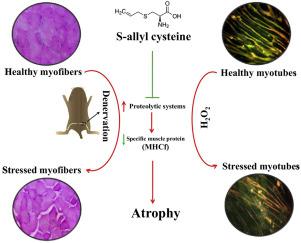Biochimica et Biophysica Acta (BBA) - General Subjects ( IF 2.8 ) Pub Date : 2020-07-07 , DOI: 10.1016/j.bbagen.2020.129676 Prachi Gupta 1 , Vikas Dutt 1 , Nirmaljeet Kaur 1 , Priya Kalra 2 , Sanjeev Gupta 1 , Anita Dua 1 , Rajesh Dabur 3 , Vikram Saini 2 , Ashwani Mittal 1

|
Background
Oxidative stress is crucial player in skeletal muscle atrophy pathogenesis. S-allyl cysteine (SAC), an organosulfur compound of Allium sativum, possesses broad-spectrum properties including immuno- and redox-modulatory impact. Considering the role of SAC in regulating redox balance, we hypothesize that SAC may have a protective role in oxidative-stress induced atrophy.
Methods
C2C12 myotubes were treated with H2O2 (100 μM) in the presence or absence of SAC (200 μM) to study morphology, redox status, inflammatory cytokines and proteolytic systems using fluorescence microscopy, biochemical analysis, real-time PCR and immunoblotting approaches. The anti-atrophic potential of SAC was confirmed in denervation-induced atrophy model.
Results
SAC pre-incubation (4 h) could protect the myotube morphology (i.e. length/diameter/fusion index) from atrophic effects of H2O2. Lower levels of ROS, lipid peroxidation, oxidized glutathione and altered antioxidant enzymes were observed in H2O2-exposed cells upon pre-treatment with SAC. SAC supplementation also suppressed the rise in cytokines levels (TWEAK/IL6/myostatin) caused by H2O2. SAC treatment also moderated the degradation of muscle-specific proteins (MHCf) in the H2O2-treated myotubes supported by lower induction of diverse proteolytic systems (i.e. cathepsin, calpain, ubiquitin-proteasome E3-ligases, caspase-3, autophagy). Denervation-induced atrophy in mice illustrates that SAC administration alleviates the negative effects (i.e. mass loss, decreased cross-sectional area, up-regulation of proteolytic systems, and degradation of total/specific protein) of denervation on muscles.
Conclusions
SAC exerts significant anti-atrophic effects to protect myotubes from H2O2-induced protein loss and myofibers from denervation-induced muscle loss, due to the prevention of elevated proteolytic systems and inflammatory/oxidative molecules.
General significance
The results signify the potential of SAC against muscle atrophy.
中文翻译:

S-烯丙基半胱氨酸:一种潜在的抗骨骼肌萎缩的化合物。
背景
氧化应激是骨骼肌萎缩发病机理的关键因素。S-烯丙基半胱氨酸(SAC)是大蒜的有机硫化合物,具有广谱特性,包括免疫调节和氧化还原调节作用。考虑到SAC在调节氧化还原平衡中的作用,我们假设SAC可能在氧化应激引起的萎缩中起保护作用。
方法
在存在或不存在SAC(200μM)的情况下,用H 2 O 2(100μM)处理C2C12肌管,以使用荧光显微镜,生化分析,实时PCR和免疫印迹方法研究形态,氧化还原状态,炎性细胞因子和蛋白水解系统。在去神经引起的萎缩模型中证实了SAC的抗萎缩潜力。
结果
SAC预孵育(4 h)可以保护肌管形态(即长度/直径/融合指数)免受H 2 O 2的萎缩作用。用SAC预处理后,在暴露于H 2 O 2的细胞中观察到较低水平的ROS,脂质过氧化,氧化型谷胱甘肽和抗氧化酶的改变。补充SAC还抑制了H 2 O 2引起的细胞因子水平(TWEAK / IL6 / myostatin)的升高。SAC处理在H也缓和肌肉特异性蛋白质(MHCf)的降解2个Ó 2由不同的蛋白水解系统的下感应支持-处理的肌管(即组织蛋白酶,钙蛋白酶,泛素蛋白酶体E3连接酶,半胱天冬酶3,自噬)。去神经引起的小鼠萎缩说明,SAC给药减轻了神经去神经作用的负面影响(即质量损失,横截面积减小,蛋白水解系统上调和总/特异性蛋白质降解)。
结论
由于防止了蛋白水解系统和炎症/氧化分子的升高,SAC发挥了显着的抗萎缩作用,以保护肌管免受H 2 O 2诱导的蛋白质损失,保护肌纤维免受失神经引起的肌肉损失。
一般意义
结果表明SAC对抗肌肉萎缩的潜力。











































 京公网安备 11010802027423号
京公网安备 11010802027423号